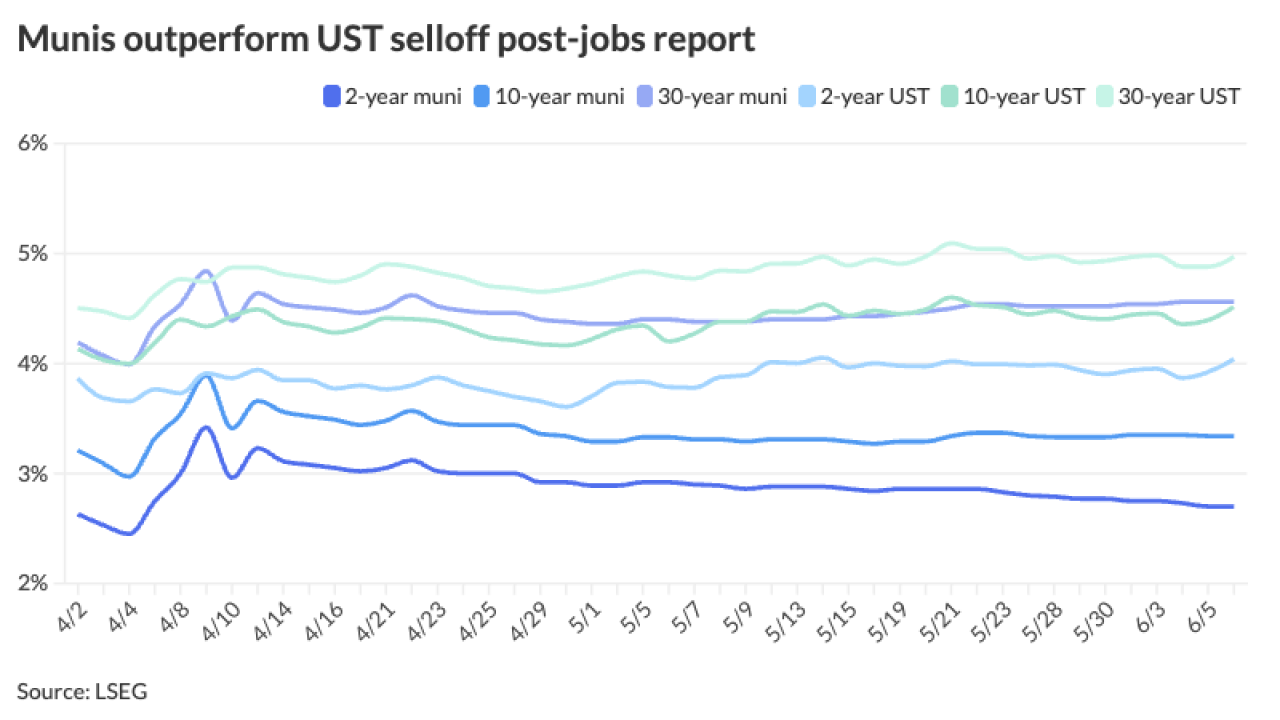Fitch Ratings takes the following rating action on Saddle Mountain Unified School District No. 90, Arizona as part of its continuous surveillance efforts:
--Approximately $13.1 million school improvement bonds, series 2003A upgraded to 'BBB-' from 'BB'.
The Rating Outlook remains Positive.
Fitch will recalibrate the underlying ratings on the above reference bonds on April 30, 2010 as described in the March 25, 2010 report 'Recalibration of U.S. Public Finance Ratings', available at 'www.fitchratings.com'. At that time, the ratings will be revised as follows:
--The rating on the series 2003A school improvement bonds will be revised to 'BBB+' with a Positive Outlook.
RATING RATIONALE:
--The upgrade reflects the district's projected near term exit from state receivership and two consecutive years of positive financial results.
--Improvement in the district's finances has been facilitated by management's implementation of a multi-year financial recovery model and more conservative fiscal practices.
--Unlike many other Arizona districts, voters recently approved extension of an operating override that provides an additional property tax revenue source and a bond authorization.
--Taxpayer concentration, comprised mainly of a nuclear power plant, is very high, somewhat offset by the plant's role as a major power provider for the southwestern U.S.
--Despite recent taxable value declines that primarily reflect the area's weakened housing market, the district's tax base remains relatively stable.
--Debt levels are modest; the district maintains a very rapid pace of debt amortization.
WHAT WOULD TRIGGER AN UPGRADE?
--Management's evidenced ability to sustain healthy fund balance levels over the near term, especially in light of possible further state spending cuts and likely lower levels of enrollment growth.
SECURITY:
The bonds are secured by an unlimited ad valorem tax levied against all taxable property within the district.
CREDIT SUMMARY:
The district was placed under state receivership in June 2007 due to substantially weak financial operations resulting in a trend of negative general fund balances and budgetary overspending dating back to fiscal 2005. However, in light of the district's progress since 2007, management has been notified that the removal of state receivership is currently underway; the district expects to exit state receivership within the next few months.
Generating a solid operating surplus in fiscal 2009, the district reversed its multi-year, negative general fund balance position, maintaining approximately $2.3 million at year's end or roughly 26% of spending in reserves on an audited basis. This was in contrast to the district's fiscal 2008 negative general fund balance of $430,000. In addition, the fiscal 2009 debt service fund balance was again positive for the second year and remained adequate at $67,000, up from a low of a negative $291,000 fund balance position in fiscal 2006. The ongoing improvement in the district's financial position has been assisted by management's implementation of the multi-year financial recovery model and more conservative fiscal practices that significantly reduced expenditures while increasing operational efficiencies. These results occurred despite an approximately $200,000 annual operating budgetary reduction required by the state for prior overspending. Further modest reductions of the district's operating and capital budgets will be required annually over time until repayment of the $3.5 million in prior years' operating over-expenditures and $178,000 in capital over-expenditures has been made.
On a budget basis, the district carried forward the maximum 4% of its revenue control limit as allowed by the state or approximately $420,000 to begin fiscal 2010. Management currently expects to close the year with about $4 million as a general fund balance on a cash basis and a lower although still adequate level of carry forward of 2% into fiscal 2011. Positive general fund balance levels are projected for fiscal 2011 and 2012, although Fitch anticipates the district will experience some financial pressure over the near term if there are additional, significant enrollment declines and/or further state funding cuts. Nonetheless, the district will maintain some financial flexibility with the recent renewal of its 10% operating tax rate override approved by voters in November 2009.
The district receives no state aid because of its property rich tax base. Nearly 80% of the district's assessed valuation (AV) is concentrated in the owners of the Palo Verde Nuclear Generating Station. Although still a credit concern, the district's concentration risk is somewhat offset by the utility's role as a major power provider for the southwestern region of the U.S. Anchored by the power plant, the district's tax base remains relatively stable, despite recent AV declines that primarily reflect the area's weakened housing market. The district expects an AV decline of 11% in fiscal 2011.
The district has $15.1 million in outstanding general obligation debt, which is equal to low 0.3% of market value due to its wealthy tax base. Debt levels are higher on a per capita basis. In addition to the operating override, voters also approved a $12 million bond authorization in November 2009, primarily for renovations to an existing elementary school facility. The district recently issued $2 million of the authorization (not rated by Fitch) and management anticipates that the bulk of the remaining authorization may be issued as soon as the summer of 2010. Very rapid amortization remains a credit positive with 100% of the district's tax-supported debt retired in less than 10 years. The district will seek a renewal of its existing capital override with voters in November 2010, which would provide continued, although lowered, levels of funding for capital spending due to recent state legislative changes that impact all Arizona school districts.
Saddle Mountain USD No. 90 encompasses 550 square miles in the west-central portion of Maricopa County and has approximately 8,500 residents. The district consists of most of the undeveloped land in the western valley of the Phoenix-Mesa Metropolitan Statistical Area (MSA), the unincorporated areas Tonopah and Wintersburg and a portion of the Town of Buckeye.





